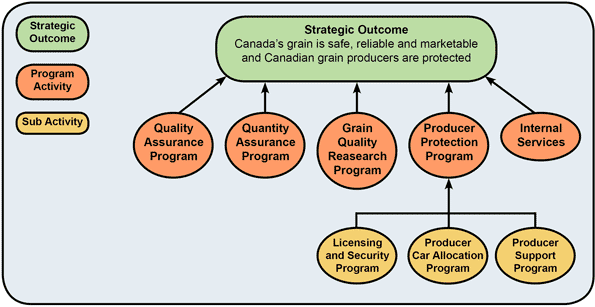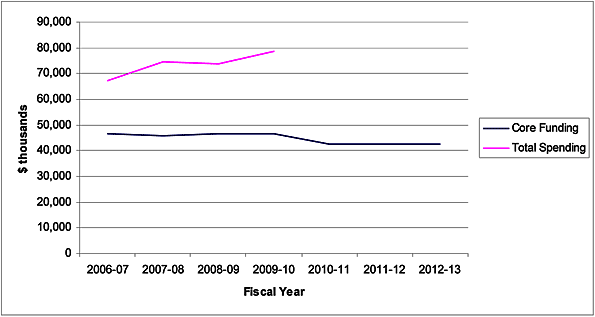Common menu bar links
Breadcrumb Trail
ARCHIVED - Canadian Grain Commission
 This page has been archived.
This page has been archived.
Archived Content
Information identified as archived on the Web is for reference, research or recordkeeping purposes. It has not been altered or updated after the date of archiving. Web pages that are archived on the Web are not subject to the Government of Canada Web Standards. As per the Communications Policy of the Government of Canada, you can request alternate formats on the "Contact Us" page.
Minister's Message

Welcome to the Canadian Grain Commission's (CGC) Report on Plans and Priorities 2010-11. This report details how the CGC intends to use its resources to carry out its responsibilities to protect grain producers' interests and to ensure a dependable commodity for Canada's international and domestic markets.
Since coming to office, this Government has worked hard with our partners in the provinces and territories and in industry on behalf of our nation's farmers. I use the word “partners” very consciously. Working side-by-side with the sector and other governments will always be the soundest approach to addressing current and emerging challenges while building on our strengths.There is another solid partnership striving to advance the interests of our farmers. The seven organizations in my Agriculture and Agri-Food (AAF) Portfolio – Agriculture and Agri-Food Canada, Canadian Food Inspection Agency, Farm Credit Canada, Canadian Grain Commission, Canadian Dairy Commission, Farm Products Council of Canada and Canada Agricultural Review Tribunal – have their own particular mandates and pursue their own activities. At the same time, these organizations share certain responsibilities, serve many of the same clients and all have the same overarching mandate to support Canada's agriculture and agri-food industry. The Portfolio's employees perform their duties with the professionalism, dedication and energy our citizens expect and deserve.
As Minister, the partner organizations of the Agriculture and Agri-Food Portfolio are an ongoing source of pride for me. Their concerted efforts demonstrate the power of collaboration in shaping a profitable and innovative agriculture sector for our country, even in the face of worldwide economic difficulties. I will continue to depend on the Portfolio's hard work and expertise as together we realize the promise of the industry's future while benefiting Canada's economy and elevating the quality of life of all Canadians.
Minister of Agriculture and Agri-Food and Minister for the Canadian Wheat Board
Chief Commissioner's Message

Welcome to the Canadian Grain Commission's (CGC) Report on Plans and Priorities for the fiscal year 2010-2011. Since 1912 the CGC has been the federal agency responsible for setting standards of quality and regulating Canada's grain handling system. Through its activities, the CGC supports a competitive, efficient grain sector and upholds Canada's international reputation for consistent and reliable grain quality. In addition, CGC producer protection activities ensure producer rights are supported to facilitate fair treatment within the licensed grain handling system. This report sets out the CGC's spending plans, priorities and expected results for the fiscal year 2010-2011 for delivering excellence and innovation in grain quality and quantity assurance, research, and producer protection.
As Chief Commissioner I look forward to the CGC's ongoing exemplary work to effectively meet the needs of producers, the industry and all Canadians in general. This report outlines how the CGC will continue to deliver the CGC's mandate under the Canada Grain Act in a time of evolving international and domestic markets, technological advances and end user requirements. In today's climate there is increased market demand for grain safety and increased sophistication of grain safety specifications. As a result, the CGC will continue efforts to not only meet today's grain safety requirements but also continue to evaluate, define and evolve the CGC's roles in testing, monitoring and assuring the safety of Canada's grain.
This report also commits the CGC to efforts that ensure Canada's Grain Quality Assurance System builds upon its reputation as the best in the world. The CGC plans to achieve this by working collaboratively with producers, industry stakeholders and government partners on the development of new technologies, protocols and a sound regulatory framework.
I invite you to read this report to learn more about the CGC's priorities, initiatives and plans for the fiscal year 2010-2011 that will ensure that Canada's grain is safe, reliable and marketable and that Canadian grain producers are protected.
Chief Commissioner
Canadian Grain Commission
Section I – Overview
1.1 Summary Information
Raison d'être
Responsibilities
Under the Canada Grain Act, the CGC regulates the handling of 21 grains1 grown in Canada to ensure Canada's grain is safe, reliable and marketable, and Canadian grain producers are protected. Canada's grain quality assurance system (GQAS), administered by the CGC, assures consistent and reliable grain quality and grain safety that meets the needs of international and domestic markets. An effective GQAS is a key factor in permitting Canadian exporters to market successfully in competitive international grain markets and is essential for producers in order to realize maximum value from their grain. The Canadian grain quantity assurance system assures the weight of grain loaded into or discharged from conveyances. In addition, the quantity assurance program assures the weight of grain in store at licensed terminal and transfer elevators. The CGC conducts grain related research in support of the GQAS to address emerging issues and permit the effective marketing of Canadian grain in the interests of producers and the Canadian grain industry. In addition, the CGC is mandated to serve producer interests by upholding the Canada Grain Act and as such has implemented a number of programs and safeguards to ensure the fair treatment of Canadian grain producers when they deliver their grain to licensed grain handling companies and grain dealers.
The CGC's head office is located in Winnipeg, Manitoba. As of September 30, 2009, the CGC employed 647 full-time equivalents and operated 12 additional offices across Canada. Funding for CGC programs and activities is through a combination of revolving fund and appropriation sources. Additional information on the CGC's mandate and responsibilities is available on the CGC website at http://www.grainscanada.gc.ca/.
1 Grain refers to any seed designated by regulation as a grain for the purposes of the Canada Grain Act. This includes barley, beans, buckwheat, canola, chick peas, corn, fababeans, flaxseed, lentils, mixed grain, mustard seed, oats, peas, rapeseed, rye, safflower seed, solin, soybeans, sunflower seed, triticale and wheat.
Strategic Outcome
To effectively pursue its mandate and make a difference to Canadians, the CGC aims to achieve the following strategic outcome:
- Canada's grain is safe, reliable and marketable and Canadian grain producers are protected
The CGC is integral to the functioning of Canada's grain industry and assures consistent and reliable grain quality and grain safety to meet the needs of international and domestic markets. This is particularly important considering Canada exported approximately $14.81 billion in cereals, grains and oilseeds during 2008. The CGC's GQAS is essential for producers to realize maximum value from their grain and the CGC is committed to providing effective producer protection services and safeguards to ensure the fair treatment of Canadian grain producers when they deliver their grain into the licensed grain handling system. CGC operations directly support Canada's efforts to brand Canadian agriculture as a leader in food safety and quality, science and innovation, and business risk management. In our role as a neutral third party regulator and arbiter, the CGC works in collaboration with virtually every participant in the grain industry.
Program Activity Architecture
The following diagram illustrates the CGC's Program Activity Architecture (PAA). The PAA is the basic structure for the management and allocation of resources to various programs and activities to achieve intended results. The CGC's PAA has five program activities. Each program activity contributes to making progress to the CGC's single strategic outcome. The producer protection program consists of three program sub-activities.

1.2 Planning Summary
The following tables provide a summary of the CGC's planned spending and human resources for the next three fiscal years. Planned spending includes the annual appropriation of $5.5 million and projected revenue earned through fees of approximately $37.1 million. The planned spending and planned FTE's shown below are reflective of approved authorities to date only and not reflective of total resource needs. The CGC is currently assessing options to ensure appropriate funding is available to maintain program delivery. For fiscal year 2009-2010, the CGC secured a total of $42.4 million in additional support to maintain programming. There are no significant planned program changes for the upcoming years.
| 2010-11* | 2011-12 | 2012-13 |
|---|---|---|
| 42 577 | 42 589 | 42 589 |
| 2010-11* | 2011-12 | 2012-13 |
|---|---|---|
| 357 | 357 | 357 |
* Planned spending differs from Main Estimates 2010-2011 with respect to non-appropriation funding because planned spending includes projected revenue earned through fees of approximately $37.1 million while Main Estimates reflects the authority limit of respendable revenue for 2010-2011 of $42.5 million.
| Performance Indicator | Targets |
|---|---|
| Number of instances where buyers are dissatisfied with CGC standards, methods or procedures used to ensure a dependable commodity for domestic and export markets | Zero instances |
| Level of producer satisfaction with CGC producer protection services | Zero unresolved or unaddressed complaints |
The following table presents planned spending by program activity and identifies the alignment of CGC program activities to the Government of Canada Outcomes.
| Program Activity1 | Forecast Spending 2009-10 ($ thousands) |
Planned Spending4 ($ thousands) |
Alignment to Government of Canada Outcomes2 | ||
|---|---|---|---|---|---|
| 2010-11 | 2012-12 | 2012-13 | |||
| Quality Assurance Program | 39 821 | 21 176 | 21 176 | 21 176 | Innovative and knowledge-based economy3 |
| Quantity Assurance Program | 12 045 | 8 479 | 8 479 | 8 479 | Innovative and knowledge-based economy3 |
| Grain Quality Research Program | 9 655 | 3 564 | 3 572 | 3 572 | Innovative and knowledge-based economy3 |
| Producer Protection Program | 4 154 | 903 | 904 | 904 | Fair and secure marketplace3 |
| Internal Services | 13 115 | 8 455 | 8 458 | 8 458 | N/A |
| Total Planned Spending | 78 790 | 42 577 | 42 589 | 42 589 | |
1 Program activity descriptions are available on the Treasury Board Secretariat Main Estimate website at: http://www.tbs-sct.gc.ca/est-pre/20102011/p2-eng.asp.
2Additional information on the Government of Canada Outcomes is available at: http://publiservice.tbs-sct.gc.ca/ppg-cpr/frame-cadre-eng.aspx.
3Further information on the CGC's alignment to the Government of Canada Outcomes is available at: http://www.grainscanada.gc.ca/cgc-ccg/cr-rm/goco-rogoc-eng.htm.
4 Planned spending for 2010-2011 and future years only includes the annual appropriation of $5.5 million and projected revenues earned through fees of approximately $37.1 million. The CGC received a total of $42.4 million in additional support in 2009-2010 to maintain programming. There are no significant planned program changes for the upcoming years.
Canadian Grain Commission Priorities
The CGC has identified the following operational and management priorities that will be the focus of attention and resources during the reporting period. These priorities and their associated strategic initiatives are aimed at strengthening the GQAS, mitigating program risks (as identified in the following section), and continuing to successfully deliver upon the CGC's sole strategic outcome of ensuring Canada's grain is safe, reliable and marketable and Canadian grain producers are protected. The CGC's level of performance in relation to these priorities will be assessed using the performance rating system provided by Treasury Board (exceeded, met all, mostly met, somewhat met or did not meet expectations). Further information on the priorities and their contributions to the program activities is available in Section II of this report.
| Operational Priorities | Type1 | Description |
|---|---|---|
| 1. Deliver services as mandated by the Canada Grain Act in a climate of constantly changing international and domestic markets, technological advancements and evolving end-user needs and preferences | Ongoing | Why is this a priority? This is a priority because it includes the majority of CGC resources and encompasses the day-to-day delivery of the CGC's programs and services necessary to deliver the CGC's mandate. Plans are aimed at continuously improving program and service delivery models and integrating new technologies and protocols into daily program/service delivery to ensure the continued successful and efficient delivery of the CGC's mandate. Strategic initiatives for meeting this priority:
|
| 2. Position the GQAS to remain relevant and support the continued competitiveness of Canadian grains in both domestic and international markets | Ongoing | Why is this a priority? Adjustments to the GQAS to remain relevant will help ensure that Canadian grain remains competitive abroad as well as at home and that producers' interests are protected. This priority is aimed at developing programs, initiatives, and new research methods and processes to maintaining and strengthening the Canadian GQAS to ensure a safe, dependable commodity. This includes the development of new technologies, protocols, and a sound regulatory framework so that the GQAS continues to evolve to address emergent and future needs. Strategic initiatives for meeting this priority:
|
| 3. Grain safety assurance | New | Why is this a priority? This is a priority due to increased market demand for grain safety and increased sophistication of grain safety specifications by buyers and food inspection authorities. This priority includes monitoring for and assurance of grain safety and working in collaboration with AAF Portfolio partners and other federal government departments and agencies in defining roles. Strategic initiatives for meeting this priority:
|
| Management Priorities | Type1 | Description |
|---|---|---|
| 1. Effective people management | Previously committed to | Why is this a priority? Effective people management will ensure the CGC continues to have motivated and engaged people with the right skills, in the right place, at the right time. This involves all elements of the CGC's People Management Framework (PMF) that sets out the strategies for meeting the CGC's current and future people needs and for meeting Public Service Renewal objectives established by the Privy Council Office. CGC strategic initiatives for meeting this priority:
|
| 2. Management Accountability | Previously committed to | Why is this a priority? This priority will ensure sound integrated and accountable management of the CGC. Strategic initiatives for meeting this priority:
|
1 Type is defined as follows: previously committed to—committed to in the first or second fiscal year prior to the subject year of the report; ongoing—committed to at least three fiscal years prior to the subject year of the report; and new—newly committed to in the subject year of the report.
Risk Analysis
The Canadian grain industry, the CGC, and the GQAS operate in a climate of constant change. The CGC and the GQAS must be able to adjust in a measured and careful fashion to these changes in order to maintain Canada's reputation as a consistent supplier of quality grain. The CGC is continually adapting programs and services to assure consistent and reliable grain quality and grain safety that meets the needs of international and domestic markets and to ensure Canadian grain producers are protected.
Risk management is an essential part of the strategic planning and decision making processes at the CGC. While the majority of risk involved in theCGC's work is inherent and constant, some risk varies according to changes in the internal and external environment. The inherent risks in CGC programs and services are addressed by continuous monitoring and adjustment in order to bring residual risk to tolerable levels, thereby maintaining high performance standards. Feedback from producers and grain handlers, domestic and international grain buyers and processors, and other government organizations is a reliable early indicator of risk arising from developments in the external environment.
Each year, an extensive environmental scan is prepared to identify emerging threats and/or opportunities for improvement. Activities to mitigate the threats and address the opportunities are identified and priorized, and in the ensuing months are integrated into operational, research, management and support work. At the end of the yearly cycle, CGC's success in managing risk can be gauged by the consistency of high performance in its services and program activities.
During 2010-11, the CGC will continue the process of developing and articulating its integrated risk management policy and corporate risk profile. The CGC has established an internal Integrated Risk Management Working Group that has been tasked with identifying and assessing high level risks, creating a broad and detailed picture of the risks facing the CGC, and ensuring that sufficient risk mitigation techniques are in place.
The following table shows key CGC program risks, and provides examples of the strategies used to mitigate and/or take advantage of those risks.
| Key Program Risk | Link to Program Activities | Examples of Risk Mitigation Strategies |
|---|---|---|
| Canada's GQAS may not align with or may be unable to respond to the requirements of domestic and international grain markets to ensure consistent and reliable grain quality, quantity and safety assurance | Successful mitigation of this risk allows the CGC to achieve the expected results associated with the Quality Assurance Program and the Quantity Assurance Program |
|
| The CGC's science and technology capacity may be unable to continue its ability to assure domestic and international markets of the consistency and high quality of Canadian Grain | Successful mitigation of this risk allows the CGC to achieve the expected results associated with the Quality Assurance Program and the Grain Quality Research Program |
|
| CGC producer protection programs may be unable to ensure that producers are compensated fairly for the quality and quantity of grain delivered and shipped | Successful mitigation of this risk allows the CGC to achieve the expected results associated with the Producer Protection Program |
|
| The CGC's workforce and work environment may not align with the current and/or future needs of the CGC | Successful mitigation of this risk allows the CGC to achieve the expected results associated with all program activities |
|
Expenditure Profile
The figure below illustrates the CGC's funding level trend for the 2006-2007 to 2012-2013 period. The two trends represented on the graph are core funding and total spending.
Total Spending against Core Funding Level Trend 2006-07 to 2012-13
Please see explanation of graph below.

For the 2006-2007 to 2009-2010 period, the total spending is reflective of all funding sources available to the CGC including appropriations realized through the full Estimates process and fees generated through the provision of services. The gap between total spending and core funding shows the CGC's reliance on funding through yearly ad hoc appropriations. Total spending from 2010-2011 to 2012-2013 does not appear on the graph due to the expiration of ad hoc funding. For the 2010-2011 to 2012-2013 periods, the graph reflects the CGC's approved authorities to date only (core funding). In the past, the CGC has received additional appropriation revenue to meet operational requirements on an ad hoc basis. For example, in 2009-2010 the CGC secured $42.4 million in additional support to maintain programming. The CGC is currently assessing options to ensure appropriate funding is available to meet operational and staffing requirements. Going forward there are no significant planned program changes.
The core funding of $42.6 million partially consists of $5.5 million in annual appropriation which is used to fund a portion of the costs related to the GRL and the functions that were associated with the Assistant Commissioner positions. The remainder of the organization's grain quality, grain quantity and producer protection programming is intended to be cost recovered via fee revenues collected primarily from inspection and weighing services. These revenues are dependent on annual grain volumes which can fluctuate up to 20% from year-to-year, resulting in variable funding from fee revenue. For fiscal year 2010-2011, the CGC forecasts fee revenues of $37.1 million generated from handling expected grain volumes of 50 million tonnes of grain. However, the CGC has fixed costs related to its statutory mandate which cannot be eliminated or reduced as revenues decline. In order to meet the evolving grain industry needs and increasing operating costs, the CGC maintains an ongoing process of cost containment and reallocates internal resources to meet new and emerging priorities.
The figure below illustrates the allocation of the CGC's funding by program activity based on the 2009-2010 forecast spending. The largest portion of the CGC's funding is allocated to the Quality Assurance Program. While the CGC has a specific program activity dedicated to producer protection activities, it is important to note that the CGC's other program activities also contribute to the CGC's overall mandate of producer protection. For example, the quality and quantity assurance programs are essential for producers to realize maximum value from their grain. With consistent mandated expectations, the percentage allocated to each program activity does not change significantly from year-to-year.
2009-2010 Allocation of Funding by Program Activity

The following table shows the voted and statutory items displayed in Main Estimates. The Vote and Statutory items reflect the CGC comparison of approved funding from year to year. In 2009-2010, the CGC received an additional $34.4 million via Supplementary Estimates that is not reflected in the Main Estimates.
